Music Educators Association of New Jersey
Serving teachers and students since 1927


The March 17th Teachers' Master Class was skillfully led
by Master Teacher Joseph Kalichstein -
world-renowned pianist, chamber musician, and veteran instructor at Juilliard.
Spring is in the air, so it must be time for the MEA Teachers' Master Class!
World-renowned pianist and Juilliard Chamber Music Chair Joseph Kalichstein returned for our annual Teachers' Master Class on St. Patty's Day this year. Members and music lovers gathered around the Steinway at the Madison NJ Library, scores in hands, ready to experience the thrill of live music. Pianists Kai Pangune Kim, Cherwyn Ambuter, and Sophia Agranovich, three of our multi-talented MEA members, brought the music of Liszt, Chopin, Piazzolla and Brahms to life for us this year. We were thrilled to listen to these three marvelous performers share their talents, piano mastery, and musical passion with us.
Our Master Teacher Joseph Kalichstein knows how to find the emotion, passion, and storyline in the music we love, and today was no exception. Mr. Kalichstein spent a half hour or so with each of our players, taking time to suggest and demonstrate different approaches to the pieces from his perspective.
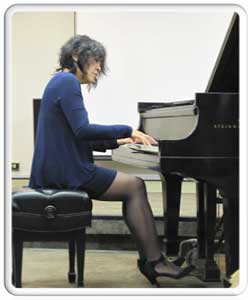
Our first performer was Kai Pangune Kim, distinguished soloist, chamber musician, and educator. Kai opened the program with the first movement of Sonata No. 2 in B flat minor, Op. 35 by Frederic Chopin. This was one of the first pieces she studied with the widely admired pianist and conductor Seymour Lipkin. Mr. Lipkin, who passed away last November, was originally scheduled to be the Master Teacher today. Kai mused, "Who would have ever known that this is the day he was supposed to give a master class, and that I would be playing this particular sonata?" We were moved as she shared the emotions of this piece with all of us through her performance. Wonderful!
Mr. Kalichstein's comments first focused in on the sound and melody of the Chopin. He noted that many people refer to Chopin as a right hand composer. He is not, but said you have to constantly listen - "...piano, pianissimo, it doesn't matter- you have to constantly adjust." He reminded us to play from the key, listening for those note and sound connections. He shared his analogy of a melody being like chewing gum. "You can stretch it, you need to feel the stretch, and still have enough body so that it will connect." He encouraged creating and feeling tension between notes, hearing the crescendo, emotional surge or whatever it is you feel, in between the notes. Think of crescendo in two places - in the stomach, and in the ear. "Keep it going inside." After doing some octave work with the piece, he shared a thought for all pianists. He believes part of our challenge of octave playing is due to habits we acquired when playing octaves at an early age. As children, we learned to grab octaves, hard. "As we grow older, we have to disabuse ourselves of that." Also, because the thumb is so much stronger than the pinky, we have to balance them constantly.
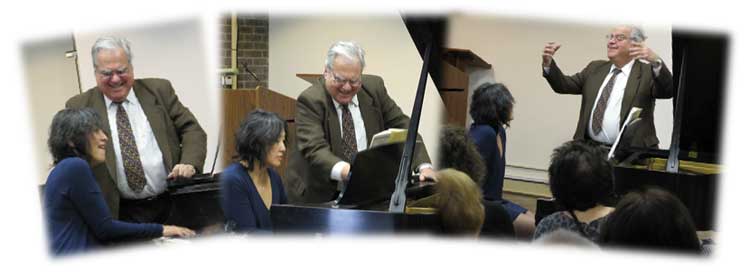
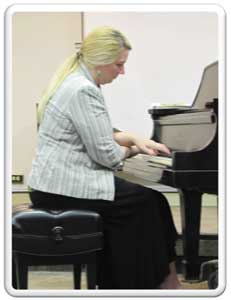
Our second performer was church organist, choral director and chamber pianist Cherwyn Ambuter. Cherwyn played two wonderfully contrasting pieces for us, Adios Nonino by Astor Piazzolla, and the Brahms Intermezzo, Op. 117, No. 2. She made us feel the power of the tango and the expressiveness of Brahms with her performances. Brava!
Mr. Kalichstein on the Piazzolla - "This is hot Argentinian music. People will dance to it, this is Tango!" He assumed the position of a dance partner, bolt upright and intense, ready to step into the dance. "You know this 'close thing' with the tango? You know, they look sexy, but they can't stand each other!" He then encouraged Cherwyn to think of the rhythm from a bass player's perspective. "The bass player is going boom, boom, boom (he plucked an imaginary upright bass to demonstrate). The world could be close to the end, he doesn't care, he's still going boom, boom, boom. Think of the rhythm all the time, even when it's free."
Then on to the Brahms! Mr. Kalichstein noted the very important expressiveness of the piece that Cherwyn conveyed to us. He suggested that when there is an opportunity for a longer melodic arc, use it - look for the longer line. As in the Chopin, he suggested generating more intensity between the notes. He imagines the 32nd notes in the piece are there to create a wind - "...it's a gentle wind, it's a nostalgic wind, but it's a wind nevertheless."
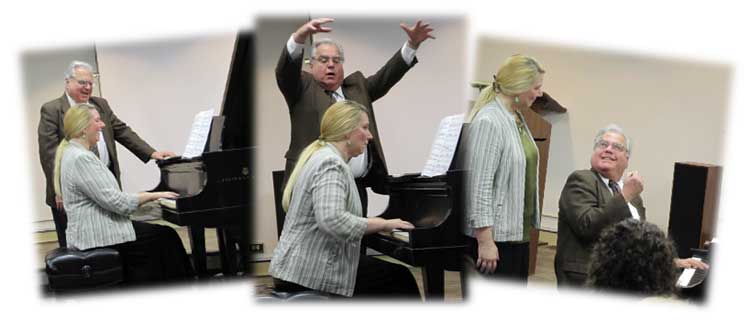
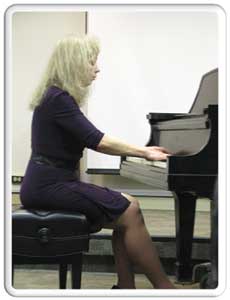
Our final performer was Sophia Agranovich, Steinway Artist, award-winning soloist, chamber musician, recording artist and educator. Sophia is also our MEA Program Committee Chair, bringing wonderful world-class musicians and pedagogues to our monthly general meetings. She engaged the audience in a high-energy performance of the Liszt Fantasia quasi Sonata (Après une Lecture du Dante), and wowed us with her stamina, which is key for this piece. Kudos and applause!
Mr. Kalichstein said to Sofia, "Quite a mouthful this piece; you understand it very well!" He remarked that he imagines the right hand melody as "a snake, moving very slowly, so take care to match the sound so that no notes stick out." He suggested giving "just a little" in the beginning of the piece - "This is just opening up, just suggesting, so don't give me full." Working on some of the two bar phrases, he suggested the left hand be 'lazier' at the end of each phrase - too much articulation could disturb the right hand line. On the performance stamina required here, Mr. Kalichstein noted, "What you want to work in a piece like this, which is nonstop, is to not to build up [muscle] tension, so whenever you get a chance, if Liszt gives you a millionth of a second, that's when you relax. Because it is so exciting, it's so easy not to, and then you're stuck." Give yourself space, and time, and think about placement of new harmonies.
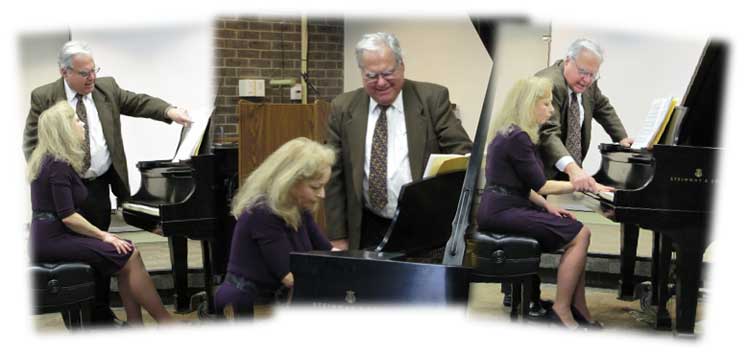
In closing our recap here, there were two topics Mr. Kalichstein touched on with the players throughout the morning: left hand practice and rubato. He encouraged a lot of left hand alone practice for all of these pieces, as they all have technical challenges that tend to pull your focus to the left hand and away from where the music really wants you to be. Hands alone practice will help the left find it's positions, keep the shifts relaxed and quick, and let the fingers do their work without the eyes and head watching over them. "If something doesn't sound the way you want, practice it - watching it won't help. Always go with your ear." On rubato he noted, "All rubato, the minute it becomes automatic, is useless. It takes control of us instead of us using it. It's a tool, but we have to decide when to use it for expressive reasons. It doesn't always add, sometimes it takes away from the music. The player should be the master, deciding how and when use rubato. Don't let it become automatic."
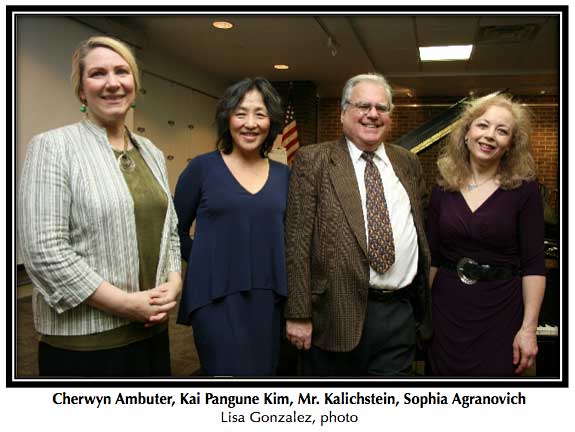
Thanks to Beverly Shea for designing the elegant Master Class program we held in our hands today, with fascinating bios of our players and Master Teacher. Finally, thank you Kai, Cherwyn, and Sophia and for tremendous playing of these wonderful and demanding diverse works, after hours and hours of preparation. As they brought to life the music of four composers who are no longer with us, I was reminded of the intriguing lyric from Broadway's "Hamilton" that poses the question, " Who lives, who dies, who tells your story?" Chopin, Piazzolla, Brahms and Liszt would have been proud of the way their musical stories were told today.
Photography and layout, Nancy Modell
Writer, Lisa Gonzalez